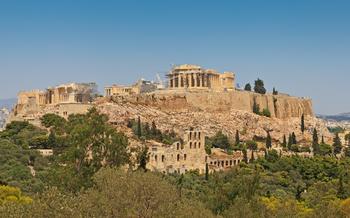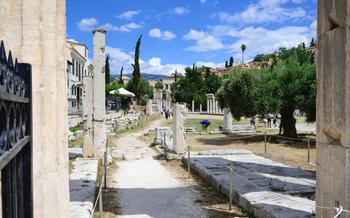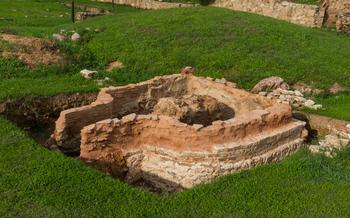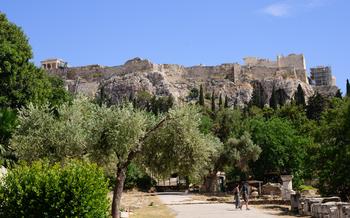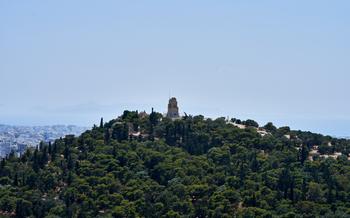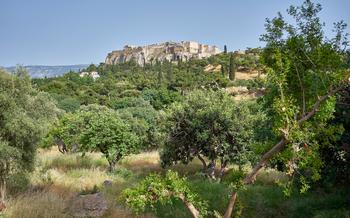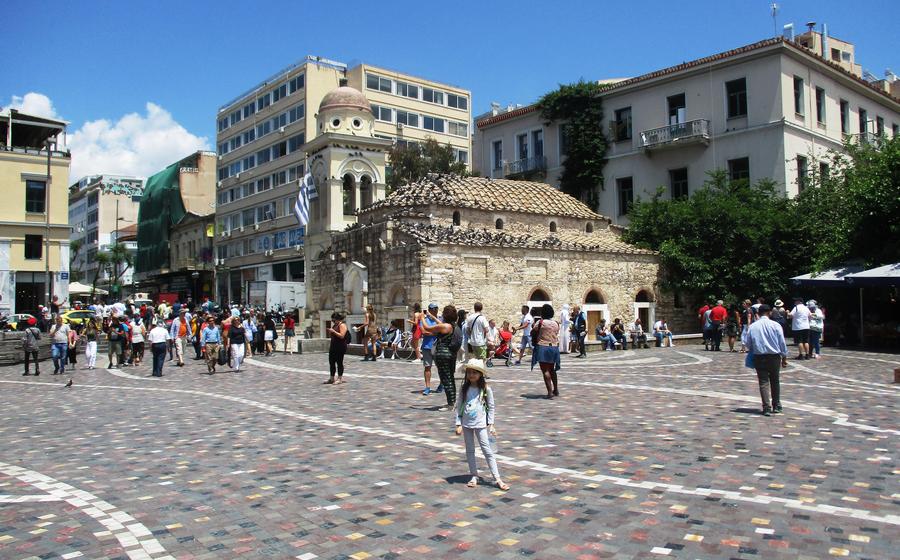
Monastiraki Square
- Monastiraki Square: A Vibrant Heart of Athens
- Unraveling the History of Monastiraki
- Exploring the Labyrinthine Streets
- The Ancient Agora: A Walk Through Time
- Tzistarakis Mosque: A Symbol of Ottoman Rule
- Church of the Holy Virgin Pantanassa: A Hidden Gem
- Monastiraki Metro Station: A Gateway to the Past
- Little Kook: A Quirky Bookstore
- Brettos: A Culinary Delight
- The Anafiotika Neighborhood: A Slice of the Cyclades
- Areopagus Hill: A Place of Ancient Justice
- The Pnyx: Where Democracy Was Born
- The Philopappos Monument: A Tribute to a Roman Consul
- Insider Tip: Explore Monastiraki at Night
Monastiraki Square: A Vibrant Heart of Athens
In the heart of Athens, nestled amidst ancient ruins and bustling streets, lies Monastiraki Square, a vibrant hub of activity and a testament to the city's rich history. Steeped in historical significance, the square has witnessed the rise and fall of civilizations, leaving behind a captivating tapestry of architectural wonders, hidden gems, and a palpable energy that draws visitors from far and wide.
As the sun casts its golden rays upon the square, the air fills with the aroma of freshly brewed coffee and the lively chatter of locals and tourists alike. Monastiraki Square serves as a central meeting point, connecting the ancient and modern worlds, where history unfolds with every step. Whether you're an avid history buff, a passionate shopper, or simply seeking an authentic Athenian experience, Monastiraki Square promises an unforgettable journey through time.
Unraveling the History of Monastiraki
Monastiraki Square, steeped in the rich tapestry of history, offers a glimpse into the diverse past of Athens. In ancient times, it was part of the bustling Agora, the city's vibrant commercial and civic center. Ruins of temples and government buildings stand as silent witnesses to the glory of ancient Athens.
During the Byzantine era, monasteries flourished in this area, leaving their mark in the square's name, which translates to "small monastery." The Tzistarakis Mosque, a beautiful reminder of Ottoman rule, still stands as a testament to the city's multicultural heritage.
In the 19th century, Monastiraki underwent a transformation, becoming a bustling commercial district and a hub for trade. Today, it seamlessly blends its ancient roots with the vibrant energy of a modern metropolis, offering a unique and captivating experience for visitors.
Exploring the Labyrinthine Streets
The labyrinthine streets of Monastiraki are a true delight to explore. Narrow alleys lined with colorful buildings, hidden shops, and street art create a vibrant and charming atmosphere. Take your time to wander through these streets, discovering the hidden gems that await around every corner.
Small boutiques selling handmade jewelry, traditional Greek pottery, and vintage clothing are nestled between cozy cafes and traditional tavernas. Street artists showcase their talent on the walls, creating a vibrant and ever-changing canvas. The air is filled with the sounds of laughter, music, and the gentle hum of everyday life.
As you explore, you'll notice the unique character of Monastiraki. The streets are a mix of old and new, with ancient ruins, Byzantine churches, and modern graffiti blending together to create a fascinating tapestry of history and culture.
Whether you're looking for souvenirs, a unique dining experience, or simply the chance to soak up the atmosphere of Athens, the streets of Monastiraki offer something for everyone. Get lost in the labyrinth, and you're sure to find treasures that will stay with you long after your visit.
The Ancient Agora: A Walk Through Time
Amidst the vibrant streets of Monastiraki lies the Ancient Agora, a captivating site that transports visitors back to the heart of ancient Athenian democracy. Once the bustling center of public life, the agora served as a marketplace, a political hub, and a place for philosophical debates. As you step through its gates, you'll be greeted by a sprawling expanse of ruins, each whispering tales of the city's glorious past.
Explore the remnants of temples dedicated to patron deities, where citizens once sought divine guidance. Marvel at the foundations of government buildings, where crucial decisions were made that shaped the course of Athenian history. And don't miss the Agora Museum, a treasure trove of artifacts that bring the ancient world to life.
Stroll along the Stoa of Attalos, a beautifully reconstructed marketplace lined with shops and offices. Imagine the lively buzz of merchants and shoppers bartering for goods, the air filled with the sounds of haggling and laughter. As you wander through the agora, let your imagination soar, picturing the philosophers Socrates and Plato engaging in spirited discussions, or the great orator Demosthenes swaying the crowd with his eloquence.
This ancient marketplace was not just a place of commerce and politics but also a vibrant center of intellectual and cultural exchange. It was here that the foundations of Western democracy were laid, and where ideas that would shape the course of human history were first debated. A visit to the Ancient Agora is a journey through time, a chance to walk in the footsteps of history and experience the birthplace of democracy firsthand.
Tzistarakis Mosque: A Symbol of Ottoman Rule
In the heart of Monastiraki Square, stands a testament to Athens' rich history under Ottoman rule - the Tzistarakis Mosque. This architectural gem, built in the 18th century, boasts intricate stone carvings, a graceful minaret, and a serene courtyard, transporting visitors back to a bygone era.
The mosque, named after the wealthy Ottoman benefactor, Mustafa Agha Tzistaraki, served as a place of worship for the Muslim community in Athens during the Ottoman period. Its construction reflects the cultural and religious diversity that characterized the city during that time.
After Greece regained its independence in the 19th century, the Tzistarakis Mosque underwent a transformation, serving various purposes, including a prison, a military warehouse, and a dance hall. Today, it has been restored to its former glory and operates as a vibrant cultural center, hosting exhibitions, concerts, and other events that celebrate the city's multicultural heritage.
The Tzistarakis Mosque stands as a poignant reminder of the Ottoman Empire's influence on Athens, showcasing the architectural legacy of a period that indelibly shaped the city's cultural identity.
Church of the Holy Virgin Pantanassa: A Hidden Gem
Amidst the vibrant streets of Monastiraki, nestled between shops and cafes, lies a hidden gem – the Church of the Holy Virgin Pantanassa. This Byzantine architectural masterpiece stands as a testament to the rich religious heritage of Athens. Its intricate mosaics, depicting biblical scenes and saints, adorn the interior walls, creating an awe-inspiring atmosphere that transports visitors back in time.
The Church of the Holy Virgin Pantanassa, with its serene and peaceful ambiance, offers a respite from the bustling city. Step inside and let the tranquility envelop you as you admire the stunning artwork and intricate details that adorn every corner of this sacred space. The church's historical significance and religious symbolism make it a must-visit destination for those interested in exploring the spiritual side of Athens.
Monastiraki Metro Station: A Gateway to the Past
As you descend into the Monastiraki Metro Station, you embark on a journey through time. The station is built on top of the ancient Athenian Agora, and during its construction, archaeologists uncovered a treasure trove of ancient artifacts. These artifacts, ranging from pottery shards to statues, are now displayed in glass panels integrated into the station's walls.
The most captivating feature of the Monastiraki Metro Station is the glass floor panels that reveal the ruins of the ancient Agora marketplace below. As you stand on these panels, you can peer down and see the foundations of ancient shops, temples, and other structures that once stood in this bustling center of ancient Athenian life.
The Monastiraki Metro Station is not just a transportation hub but also a fascinating archaeological site. It offers a unique opportunity to combine history and modernity, allowing you to travel through time as you commute through the heart of Athens.
Little Kook: A Quirky Bookstore
Amidst the vibrant streets of Monastiraki, nestled between souvenir shops and bustling cafes, lies a literary haven known as Little Kook. This charming bookstore is a testament to the enduring power of printed words and the magic of storytelling. Step inside, and you'll be transported to a world of forgotten tales, hidden gems, and literary treasures.
The shelves at Little Kook are a bibliophile's paradise, overflowing with a diverse collection of books that span genres, languages, and eras. From classic literature and contemporary fiction to rare editions and obscure titles, there's something for every reader's taste. The knowledgeable and friendly staff is always on hand to offer personalized recommendations, ensuring that you leave with a stack of books that will ignite your imagination and keep you turning the pages long after you've left the store.
What sets Little Kook apart is its unique ambiance. The store's cozy atmosphere invites you to linger, curl up in a corner with a good book, and let the world melt away. The resident cats, who roam freely among the shelves, add a touch of whimsy and charm to the space. Whether you're a seasoned bookworm or simply looking for a quiet retreat, Little Kook is the perfect place to lose yourself in the written word and discover new literary adventures.
Brettos: A Culinary Delight
Amidst the vibrant streets of Monastiraki, Brettos stands as a culinary beacon, inviting travelers to savor the authentic flavors of traditional Greek cuisine. A family-run establishment, Brettos has been a beloved institution in Athens for over a century, serving mouthwatering dishes that have delighted generations of locals and visitors alike.
The menu at Brettos is a testament to the richness and diversity of Greek gastronomy. From classic meze platters overflowing with fresh seafood, succulent grilled meats, and tangy cheeses to hearty stews simmering with aromatic spices, Brettos offers a culinary journey that showcases the finest ingredients and flavors of Greece.
Must-try dishes include the succulent lamb chops, grilled to perfection and seasoned with herbs from the mountains of Crete, the moussaka, a hearty casserole of eggplant, potatoes, and minced lamb topped with a creamy béchamel sauce, and the pastitsio, a baked pasta dish with minced beef, béchamel, and kefalotyri cheese.
The atmosphere at Brettos is warm and welcoming, with friendly staff who are always ready to offer recommendations and share stories about the history of the restaurant and the dishes on the menu. Whether you choose to dine in the cozy interior or soak up the lively atmosphere of Monastiraki Square, Brettos promises an unforgettable culinary experience that will leave you craving for more.
The Anafiotika Neighborhood: A Slice of the Cyclades
Nestled on the slopes of the Acropolis, the Anafiotika neighborhood is a charming oasis that transports visitors to the picturesque islands of the Cyclades. With its whitewashed houses, narrow cobblestone streets, and stunning views of the ancient citadel, Anafiotika offers a tranquil escape from the bustling city below.
Founded in the 19th century by workers from the Cycladic island of Anafi, who were brought to Athens to help rebuild the city after the Greek War of Independence, the neighborhood retains its unique island character. The Cycladic influence is evident in the architecture, with its low-rise houses featuring whitewashed walls, blue-painted doors and windows, and flat roofs.
The narrow streets of Anafiotika wind their way up the hill, creating a labyrinthine maze that is a joy to explore. Bouganvillea and jasmine vines cascade over the walls, adding a splash of color to the whitewashed facades. The neighborhood is home to a few traditional tavernas and cafes, where visitors can relax and soak up the tranquil atmosphere.
One of the highlights of Anafiotika is its stunning views of the Acropolis. From the neighborhood's vantage point, visitors can admire the ancient citadel in all its glory, with the Parthenon and the Erechtheion standing proudly against the backdrop of the Athenian sky.
A stroll through Anafiotika is a delightful experience that allows visitors to escape the hustle and bustle of the city and immerse themselves in the charm of a traditional Greek island village.
Areopagus Hill: A Place of Ancient Justice
Areopagus Hill, also known as Mars Hill, is a prominent rocky outcrop located northwest of the Acropolis. It derives its name from Ares, the Greek god of war, and pagos, meaning "hill." In ancient times, it was a place of great significance, serving as the meeting place of the Areopagus Council, a body of respected Athenian elders who handled matters of homicide, religious crimes, and other important issues.
The Areopagus Council was highly revered for its wisdom and impartiality, and its decisions were considered final. It is believed that the apostle Paul addressed the council during his visit to Athens, as recorded in the book of Acts in the New Testament. Today, visitors can climb the hill to admire the stunning views of the Acropolis, the ancient Agora, and the city of Athens. The hill is a popular spot for contemplation and reflection, offering a glimpse into the rich history and cultural heritage of ancient Greece.
The Pnyx: Where Democracy Was Born
The Pnyx, a rocky hill located west of the Acropolis, holds a significant place in the history of democracy. It served as the birthplace of Athenian democracy in the 6th century BC, where citizens would gather to debate and make decisions on matters affecting their city.
The Pnyx was initially a natural amphitheater, but it underwent modifications during the 5th century BC to accommodate the growing number of participants. A large platform was constructed to provide a stage for orators, and stone benches were arranged in tiers to seat the audience.
The Pnyx was the birthplace of Athenian democracy, a system of government that allowed citizens to participate directly in the decision-making process. This concept of direct democracy, where citizens had the power to make laws and elect officials, was a radical idea at the time and had a profound impact on the development of democracy worldwide.
The Pnyx also played a crucial role in the Peloponnesian War, a devastating conflict between Athens and Sparta. The speeches delivered at the Pnyx during this time were instrumental in shaping public opinion and mobilizing support for the war effort.
Today, the Pnyx stands as a symbol of the origins of democracy. It is a popular tourist destination, and visitors can explore the site and imagine the vibrant debates that took place here over 2,500 years ago.
The Philopappos Monument: A Tribute to a Roman Consul
Amidst the ancient ruins of Athens, stands the Philopappos Monument, a grand testament to the Roman Empire's influence on the city. Erected in the 2nd century AD, this towering monument was dedicated to Gaius Julius Antiochus Philopappos, a Roman consul and a descendant of the last king of Commagene, a kingdom in what is now southeastern Turkey.
The Philopappos Monument is a remarkable example of Roman architecture, featuring a large, square base adorned with intricate reliefs depicting scenes from Philopappos's life and military achievements. Atop the base stands a cylindrical column, which once supported a statue of Philopappos, though the statue itself is now lost to time.
The monument offers breathtaking panoramic views of Athens. From its vantage point on the slopes of the Hill of the Nymphs, visitors can gaze upon the ancient Agora, the Acropolis, and the sprawling cityscape beyond. The monument is a popular spot for photography enthusiasts and history buffs alike, who come to admire its grandeur and learn about its fascinating history.
The Philopappos Monument stands as a reminder of the Roman Empire's enduring impact on Athens. Even today, over two thousand years after its construction, the monument continues to inspire awe and admiration, serving as a tangible link to the city's rich and multifaceted past.
Insider Tip: Explore Monastiraki at Night
As the sun sets over Athens, Monastiraki transforms into a vibrant nocturnal haven. The square comes alive with a different kind of energy, as locals and tourists alike gather to soak in the city's vibrant nightlife. The streets illuminate, casting a warm glow on the ancient ruins and historical landmarks.
Monastiraki becomes a stage for various night markets, where vendors display their unique wares, from handcrafted jewelry and souvenirs to vintage clothing and antiques. The air fills with the sounds of live music and laughter, creating a festive atmosphere that invites exploration and discovery.
Take advantage of the cooler evening temperatures to wander through the narrow alleys and hidden corners of Monastiraki. Discover charming tavernas tucked away between the buildings, offering traditional Greek cuisine and local delicacies. Experience the warmth of Greek hospitality as you savor delicious dishes and engage in lively conversations with the locals.
Whether you're seeking a memorable shopping experience, a culinary adventure, or simply a chance to immerse yourself in the vibrant energy of Athens, exploring Monastiraki at night is an experience not to be missed. Embrace the city's nocturnal charm and let the magic of Monastiraki captivate you under the starry Athenian sky.
